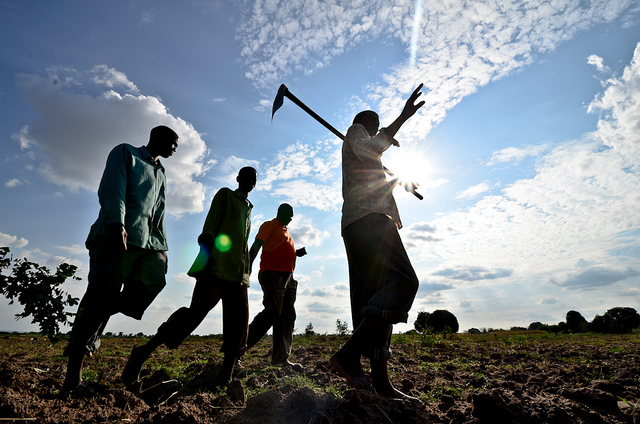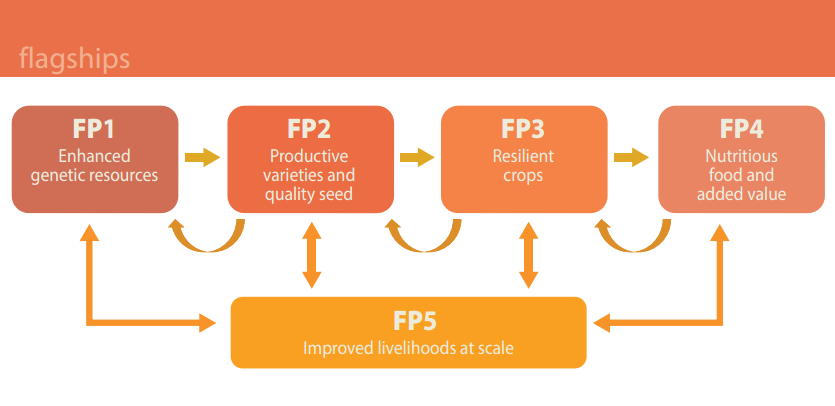More than 300 million people below the poverty line in developing countries depend on root, tuber and banana crops for food and income, particularly in Africa, Asia and the Americas. The CGIAR Research Program on Roots, Tubers and Bananas (RTB) is working globally to harness the untapped potential of those crops in order to improve food security, nutrition, income and climate change resilience of smallholders, especially women and youth.

Photo N.Palmer/CIAT
Why roots, tubers and bananas?
Root, tuber and banana crops – cassava, potatoes, sweetpotatoes, yams, bananas, plantains, and tropical and Andean roots and tubers– are some of the most important staple crops in the world’s poorest regions. They provide around 15% or more of the daily per capita calorie intake for the 763 million people living in the least developed countries. Often rich in key nutrients such as provitamin A, RTB crops can significantly improve nutrition and food security. Many RTB crops can be grown with few inputs and often under harsh conditions. Yet they respond very well to intensification and are high yielders in terms of calories produced per hectare. As important cash crops they can help boost family incomes and are frequently grown or marketed by women. But RTB crops present several common challenges. They are propagated clonally rather than with seeds, which allows yield-reducing pathogens to build up over time. This calls for a strong design of private-public seed systems. The crops’ bulk and perishability put pressure on postharvest innovation. High genetic complexity in any variety means breeding is especially difficult.
Who are we?
RTB is a partnership collaboration of five research centers, led by the International Potato Center, with decades of experience in these crops on different continents, including four CGIAR research centers (Bioversity International, the International Center for Tropical Agriculture, the International institute of Tropical Agriculture and the International Potato Center) and the French Agricultural Research Centre for International Development (CIRAD). By working with more than 360 other partners, these five centers mobilize complementary expertise and resources; avoid duplication of efforts; and create synergies to increase the benefits of their research for smallholder farmers, consumers and other stakeholders.
What are we doing differently?
RTB is changing the way the research centers work and collaborate, creating a more cohesive and multidisciplinary approach to common challenges and goals. RTB aims to promote greater cooperation among an array of national and international institutions, NGOs and stakeholders’ groups while strengthening their capacities as key players. Because the full impact of RTB research depends on how well next- and end-users adopt it, the program places great emphasis on scaling through a dedicated Flagship Project 5 on ‘Improved Livelihoods at Scale’. FP5 works together with the program’s four other flagships to disseminate innovations across larger populations in regions where root, tuber and banana crops are grown. Towards this end, RTB’s research options are developed together with stakeholders and are informed by their needs and preferences. Women are widely involved in the growing and marketing of RTB crops. Yet they face a different set of constraints than men, and have traditionally been the last to benefit from agricultural research and extension. RTB’s comprehensive gender strategy is guiding the RTB gender research portfolio in order to improve and implement gender responsiveness. RTB crops also present a wide range of options to stimulate youth employment in processing and seed systems.
How we work
RTB organizes research around five linked and interactive flagship projects (FPs).
- Flagship project 1 – Discovery research for enhanced utilization of RTB genetic resources
- Flagship project 2 – Adapted productive varieties and quality seed
- Flagship project 3 – Resilient crops
- Flagship project 4 – Nutritious food and added value through post-harvest innovation
- Flagship project 5 – Improved livelihoods at scale

